Study on the Seismic Response of Shield Tunnel Structures with the Preload Loss of Bolts
Abstract
:1. Introduction
2. Numerical Simulation
2.1. Soil-Shield Tunnel Model
2.2. Material Parameters
2.3. Method of Applying Preload
2.4. Seismic Wave and Boundary Conditions
3. Validation of Joints Model
4. Result Analysis
4.1. Joints Opening Analysis
4.2. Ellipticity Analysis
4.3. Acceleration Response Analysis
4.4. Radial Deformation Analysis
4.5. Settlement Analysis
4.6. Tensile Damage Analysis
5. Conclusions
Author Contributions
Funding
Institutional Review Board Statement
Informed Consent Statement
Data Availability Statement
Conflicts of Interest
References
- Chen, X.; Li, K.; Bao, X.; Hong, C.; Fu, Y.; Cui, H. Innovations in the Development of Digital and Intelligent Construction of Urban Shield Tunnels. J. Basic Sci. Eng. 2021, 29, 1057–1074. [Google Scholar] [CrossRef]
- Chen, X.; Shen, J.; Bao, X.; Wu, X.; Tang, W.; Cui, H. A review of seismic resilience of shield tunnels. Tunn. Undergr. Space Technol. 2023, 136, 105075. [Google Scholar] [CrossRef]
- He, C.; Geng, P. Research on Practical Seismic Analysis Methods of Shield Tunnel. China J. Highw. Transp. 2020, 33, 15–25. [Google Scholar] [CrossRef]
- Zhang, J.; He, C.; Geng, P.; Chen, P.; Lu, Z. Study on bending state nonlinearity of shield-tunnel ring joints. Eng. Mech. 2018, 35, 35–44. [Google Scholar] [CrossRef]
- He, C.; Geng, P.; Yan, Q.; Feng, K. Status of seiemic analysis methods for traffic yunnel and their applicability suggestions in China. J. Earthq. Tsunami 2013, 7, 1350026. [Google Scholar] [CrossRef]
- Geng, P.; Tang, J.; Quan, Q.; He, C.; Yan, Q. Shaking table test for tunnel with shock absorption layer though fault zone. J. Cent. South Univ. Sci. Technol. 2013, 44, 2520–2526. [Google Scholar]
- Xu, H.; Li, T.; Xia, L.; Zhao, J.X.; Wang, D. Shaking table tests on seismic measures of a model mountain tunnel. Tunn. Undergr. Space Technol. 2016, 60, 197–209. [Google Scholar] [CrossRef]
- Dong, F.; Zhang, D.; Fang, Q.; Zhu, W.; Chen, L.; Tai, Q. Seismic Response Analysis of Large-Diameter Shield Tunnels Considering the Segment Joint Effect. Mod. Tunn. Technol. 2015, 52, 111–120. [Google Scholar] [CrossRef]
- Xu, H.; Li, T.; Xu, J.; Wang, Y. Dynamic Response of Underground Circular Lining Tunnels Subjected to Incident P Waves. Math. Probl. Eng. 2014, 2014, 1350026. [Google Scholar] [CrossRef]
- Liu, N.; Men, Y.; Peng, J.; Chu, C.; Liu, Y. Dynamic response of shield metro tunnel in earthquake load. Hydrogeol. Eng. Geol. 2010, 37, 58–62. [Google Scholar] [CrossRef]
- Wang, Q.; Geng, P.; Chen, C.; Chen, J.; He, C. Determination of seismic response of reinforced tunnel portal slope using shaking table tests. Tunn. Undergr. Space Technol. 2023, 136, 105072. [Google Scholar] [CrossRef]
- Liang, J.; Xu, A.; Ba, Z.; Wu, Z.; Yan, Q.; Zhu, Y. Seismic response of ultra-large diameter shield tunnel in upper-soft and lower-hard site: Shaking table tests and numerical simulations. Soil Dyn. Earthq. Eng. 2023, 164, 107634. [Google Scholar] [CrossRef]
- Bao, Z.; Yuan, Y.; Yu, H. Multi-scale physical model of shield tunnels applied in shaking table test. Soil Dyn. Earthq. Eng. 2017, 100, 465–479. [Google Scholar] [CrossRef]
- Tao, L.; Shi, C.; Ding, P.; Yang, X.; Bao, Y.; Wang, Z. Shaking table test of the effect of an enclosure structure on the seismic performance of a prefabricated subway station. Tunn. Undergr. Space Technol. 2022, 125, 104533. [Google Scholar] [CrossRef]
- Sun, W.; Guan, Z.; Chen, Y.; Pan, J.; Zeng, Y. Modeling of Preload Bolted Flange Connection Structure for Loosening Analysis and Detection. Shock. Vib. 2022, 2022, 7844875. [Google Scholar] [CrossRef]
- Zhang, G.; Zhang, W.; Li, J.; Zhou, X.; Liu, W.; Qi, J. Study on Assembly and Tensile Performance of Circumferential Anchor Joint for Shield Tunnel Considering Roughness and Size of Structure. KSCE J. Civ. Eng. 2023, 27, 2263–2274. [Google Scholar] [CrossRef]
- Zhu, Y.; Liu, X.; Zhang, C.; Zhang, C. Contrast test research on longitudinal joint withdifferent forms of bolts in metro shield tunnel. J. Rail Way Sci. Eng. 2015, 12, 1427–1435. [Google Scholar] [CrossRef]
- Zhang, W.; Qi, J.; Zhang, G.; Niu, R.; Zhang, C.; He, L.; Lyu, J. Full-scale experimental study on failure characteristics of the key segment in shield tunnel with super-large cross-section. Tunn. Undergr. Space Technol. 2022, 129, 104671. [Google Scholar] [CrossRef]
- Zhang, W.; Zhang, G.; Li, H.; Gao, W.; Guo, W.; Gao, P. Waterproof Performance of Sealing Gaskets and Impact of Construction Loads on Segment Joints in Shield Tunnel. China J. Highw. Transp. 2020, 33, 130–141. [Google Scholar] [CrossRef]
- Sun, F.; Li, W.; Li, C. Response Relationship between Longitudinal Joint Opening and Convergence Deformation of River Crossing Shield Tunnel. Chin. J. Undergr. Space Eng. 2023, 19, 309–318. [Google Scholar]
- Yin, J.; Jin, H.; Gong, Q.; Zhou, S. Effect of Circumferential Bolt Corrosion on Ultimate Bearing Capacity of Shield Tunnel. Chin. J. Undergr. Space Eng. 2020, 16, 508–515. [Google Scholar]
- Zhang, D.; Chen, C. Time-dependent Reliability Analysis of Shield Tunnel Structure under Corrosion Conditions of Segment Rebars and Bolts. Mod. Tunn. Technol. 2021, 58, 111–120. [Google Scholar] [CrossRef]
- Zeng, D.; He, C. Numerical Simulation of Segment Joint Bending Stiffness of Metro Shield Tunnel. J. Southwest Jiaotong Univ. 2004, 39, 744–748. [Google Scholar] [CrossRef]
- Li, F.; Gou, C.; Xu, D. Study on Structure Inner Forces Affected by Shield Tunnel Segment Joint Bending Stiffness. J. Wuhan Univ. Technol. 2013, 35, 73–78. [Google Scholar] [CrossRef]
- Peng, Y.; Gong, C.; Ding, W.; Lei, M.; Shi, C.; Wang, Y. Fluid-structure coupling model of shield tunnel considering seepage of segmental joints. China Civ. Eng. J. 2022, 55, 95–108. [Google Scholar] [CrossRef]
- Bao, X.; Li, P.; Cui, H.; Zhu, H. Dynamic Response of Complex Soft Clay due to Mero Tunnel Operation. Mod. Tunn. Technol. 2018, 55, 53–60. [Google Scholar] [CrossRef]
- Bao, X.; Xia, Z.; Ye, G.; Fu, Y.; Su, D. Numerical analysis on the seismic behavior of a large metro subway tunnel in liquefiable ground. Tunn. Undergr. Space Technol. 2017, 66, 91–106. [Google Scholar] [CrossRef]
- GB50010-2010; Code for Design of Concrete Structures. State Standard of the People’s Republic of China: Shanghai, China, 2011; p. 133.
- Zhang, W.; Zhang, Q.; Cao, W. Study on Stress and Deformation of Bolt Joints of Shield Tunnel under Static and Seismic Action. KSCE J. Civ. Eng. 2021, 25, 3146–3159. [Google Scholar] [CrossRef]
- JGJ 82-20112011; Technical Pecification for High Strength Bolt Connections of Steel Structures. State Standard of the People’s Republic of China: Shanghai, China, 2011; p. 78.
- Gao, F.; Zhao, F. Study on transformation method for artificial boundaries in static-dynamic analysis of underground structure. J. Vib. Shock. 2011, 30, 165–170. [Google Scholar] [CrossRef]
- Liu, J.; Wang, Z.; Zhang, K.; Pei, Y. 3d finite element analysis of large dynamic machine foundation considering soil-structure interaction. Eng. Mech. 2002, 19, 34–38. [Google Scholar] [CrossRef]
- Liu, J.; Gu, Y.; Du, Y. Consistent viscous-spring artificial boundaries and viscous-spring boundary elements. Chin. J. Geotech. Eng. 2006, 28, 1070–1075. [Google Scholar]
- Gu, Y.; Liu, J.; Du, Y. 3D consistent viscous-spring artificial boundary and viscous-spring boundary element. Eng. Mech. 2007, 24, 31–37. [Google Scholar] [CrossRef]
- He, J.; Ma, H.; Zhang, B.; Chen, H. Method and realization of seismic motion input of viscous-spring boundary. J. Hydraul. Eng. 2010, 41, 960–969. [Google Scholar] [CrossRef]
- GB 50909-20142014; Code for Seismic Design of Urban Rail Transit Structures. State Standard of the People’s Republic of China: Shanghai, China, 2014; p. 185.
- Zuo, L.; Li, G.; Feng, K.; Ma, X.; Zhang, L.; Qiu, Y.; Cao, S.; Feng, L. Experimental analysis of mechanical behavior of segmental joint for gas pipeline shield tunnel under unfavorable compression-bending loads. Tunn. Undergr. Space Technol. 2018, 77, 227–236. [Google Scholar] [CrossRef]
- Zheng, G.; Zhang, X.; Zhang, T.; Sun, J.; Qiu, H.; Diao, Y. Numerical study on mechanical behavior and ultimate bearing capacity of shield segment joints under different load conditions. Tunn. Undergr. Space Technol. Inc. Trenchless Technol. Res. 2023, 139, 105204. [Google Scholar] [CrossRef]
- Travasarou, T.; Bray, J.D.; Abrahamson, N.A. Empirical attenuation relationship for Arias Intensity. Earthq. Eng. Struct. Dyn. 2003, 32, 1133–1155. [Google Scholar] [CrossRef]
- Liu, J.M.; Gao, M.T.; Xie, J.J. Spatial Variability and Attenuation of Arias Intensity during the 1999 Chi-Chi Mw 7.6 Earthquake, Taiwan. Bull. Seismol. Soc. Am. 2015, 105, 1768–1778. [Google Scholar] [CrossRef]
- Amiri, G.G.; Mahmoodi, H.; Amrei, S.A.R. Seismic hazard assessment of Tehran based on Arias intensity. In Proceedings of the 2008 Seismic Engineering Conference Commemorating the 1908 Messina and Reggio Calabria Earthquake, PTS 1 and 2, Reggio Calabria, Italy, 8–11 July 2008. [Google Scholar] [CrossRef]
- Liu, J.M.; Wang, T.; Wu, S.R.; Gao, M.T. New Empirical Relationships between Arias Intensity and Peak Ground Acceleration. Bull. Seismol. Soc. Am. 2016, 106, 2168–2176. [Google Scholar] [CrossRef]
- Campbell, K.W.; Bozorgnia, Y. A Comparison of Ground Motion Prediction Equations for Arias Intensity and Cumulative Absolute Velocity Developed Using a Consistent Database and Functional Form. Earthq. Spectra 2012, 28, 931–941. [Google Scholar] [CrossRef]
- Chao, L.; Zhuohua, P.; Jie, C.; Xiangyun, H.; Yadong, L.; Weiyun, C. Development of crack and damage in shield tunnel lining under seismic loading: Refined 3D finite element modeling and analyses. Thin-Walled Struct. 2023, 185, 110647. [Google Scholar] [CrossRef]
- Jin, H.; Yu, K.; Gong, Q.; Zhou, S. Load-carrying capability of shield tunnel damaged by shield shell squeezing action during construction. Thin-Walled Struct. 2018, 132, 69–78. [Google Scholar] [CrossRef]
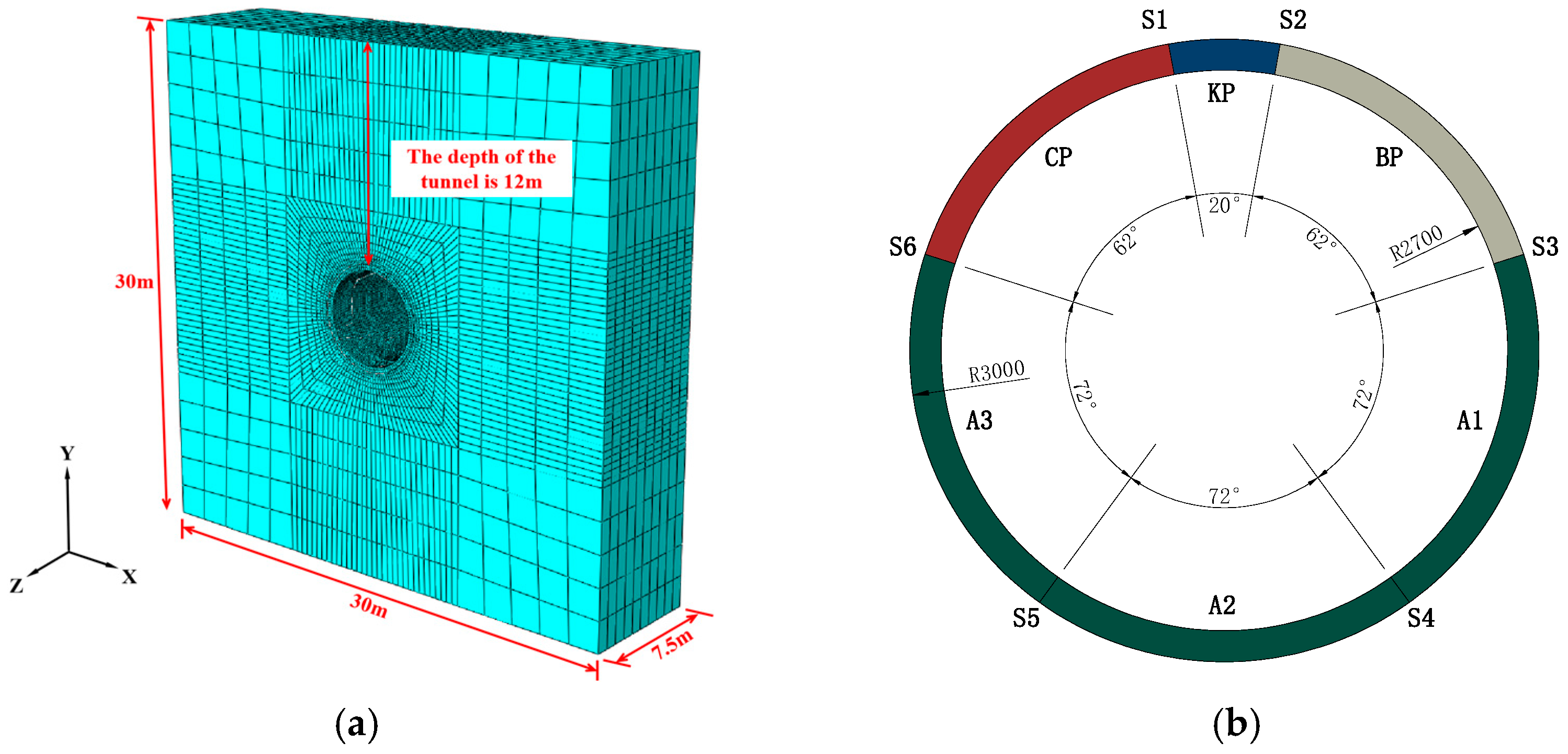
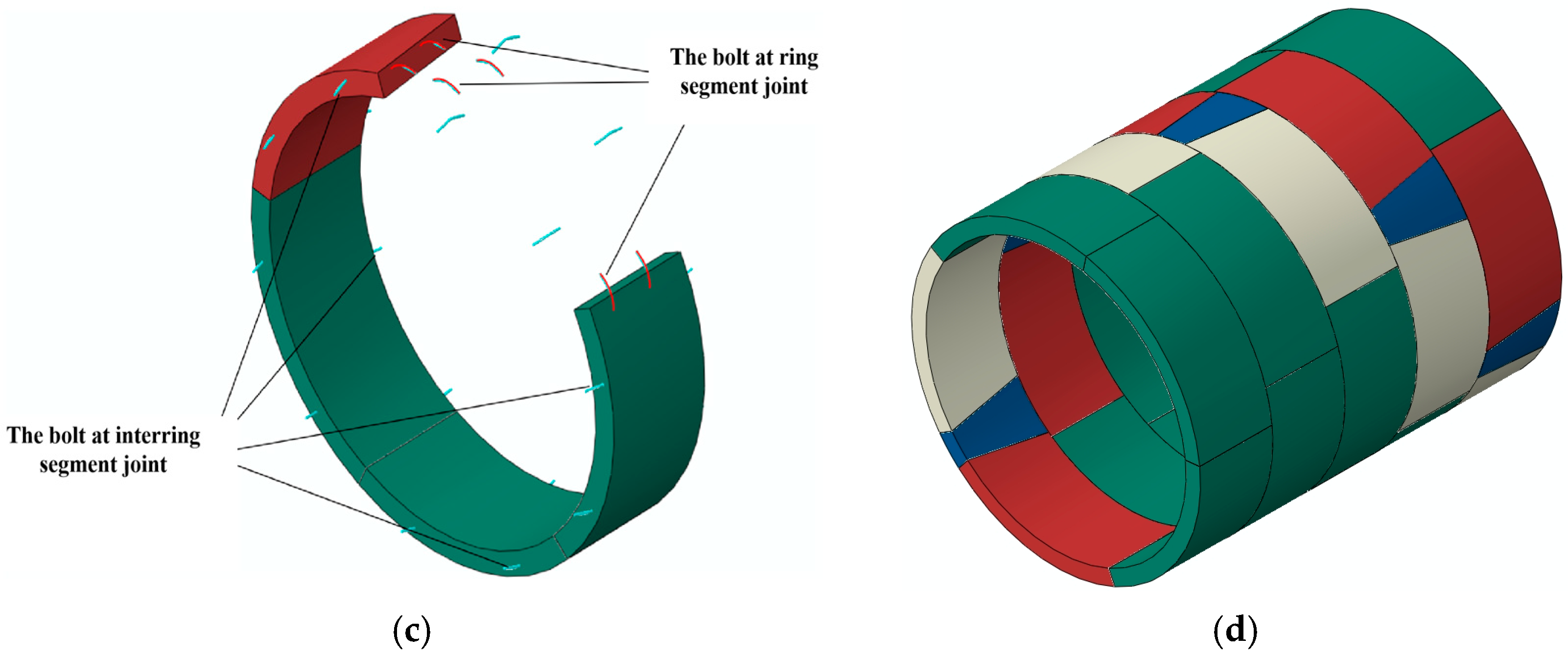

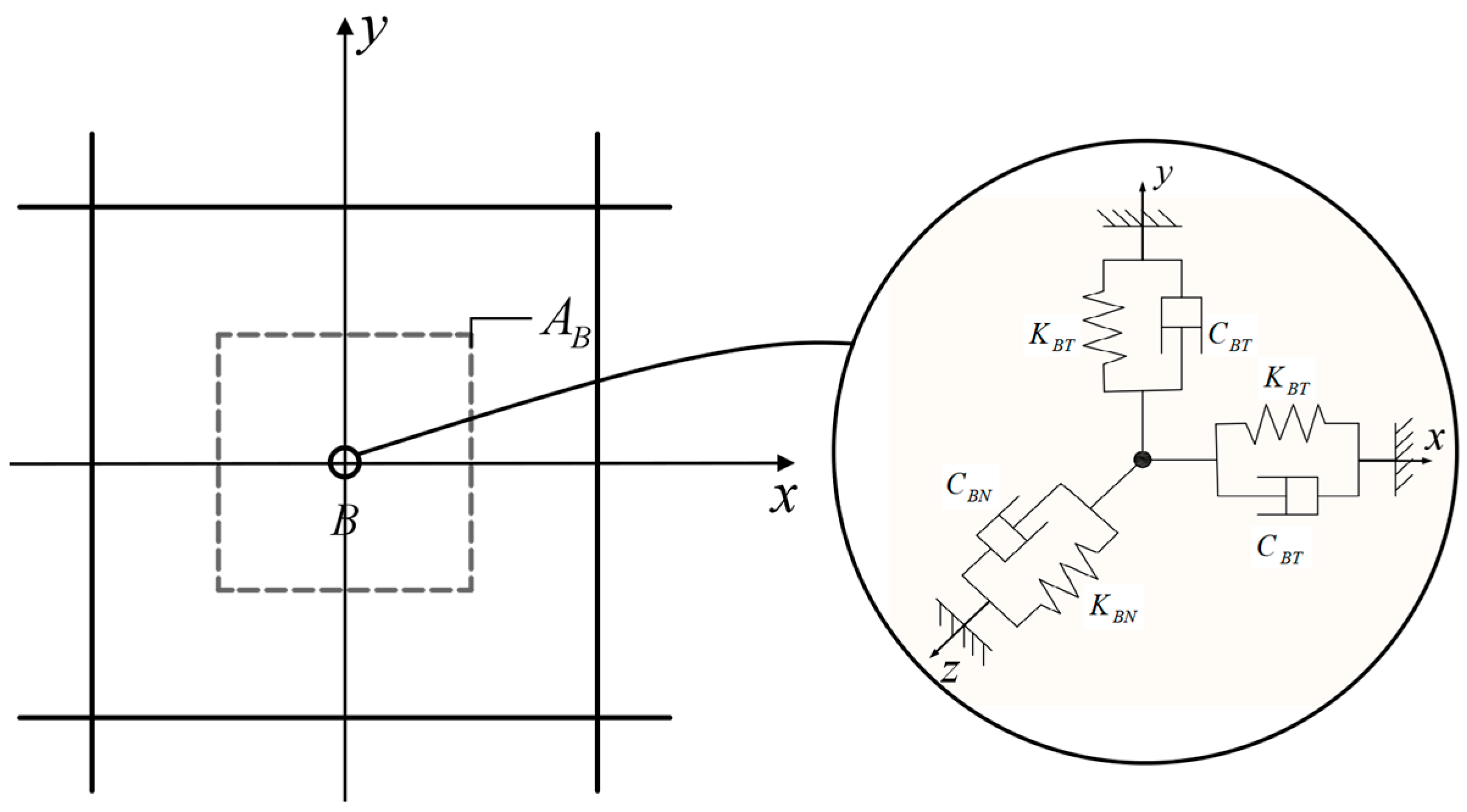
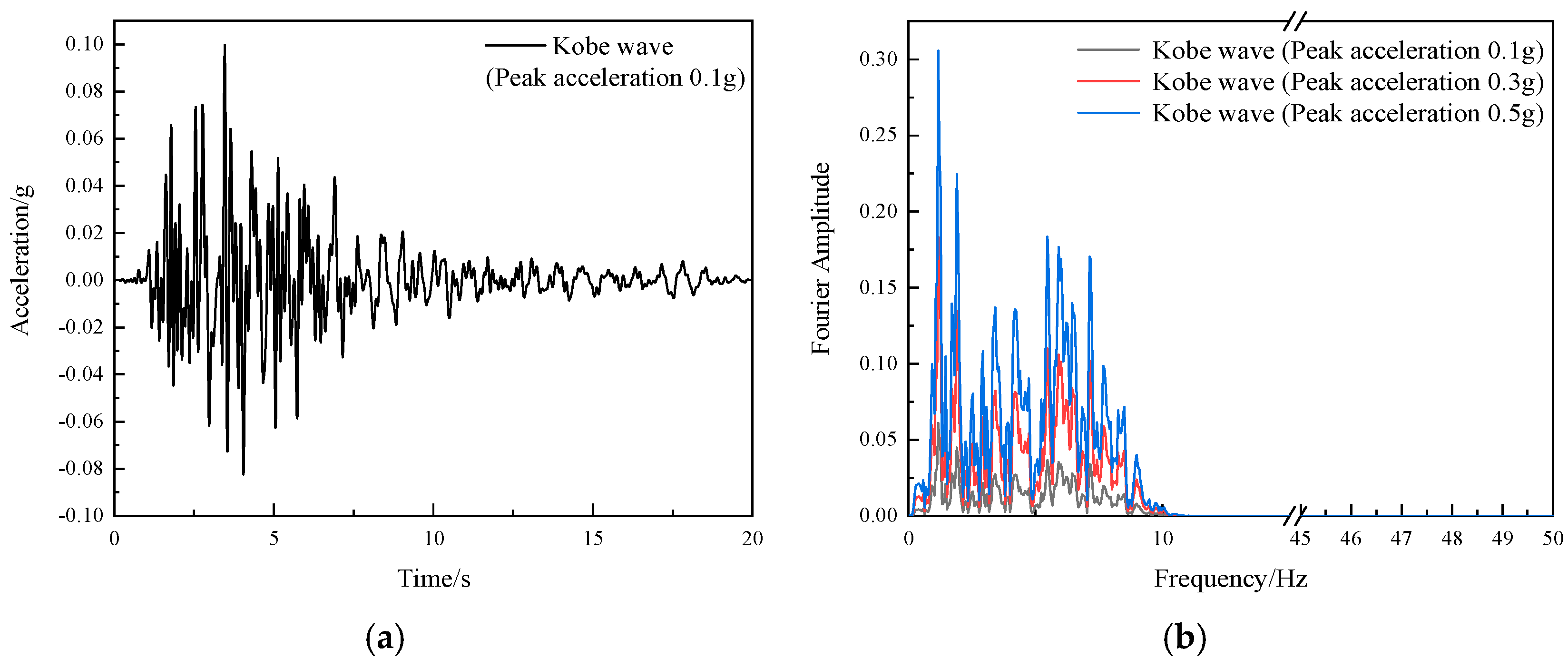

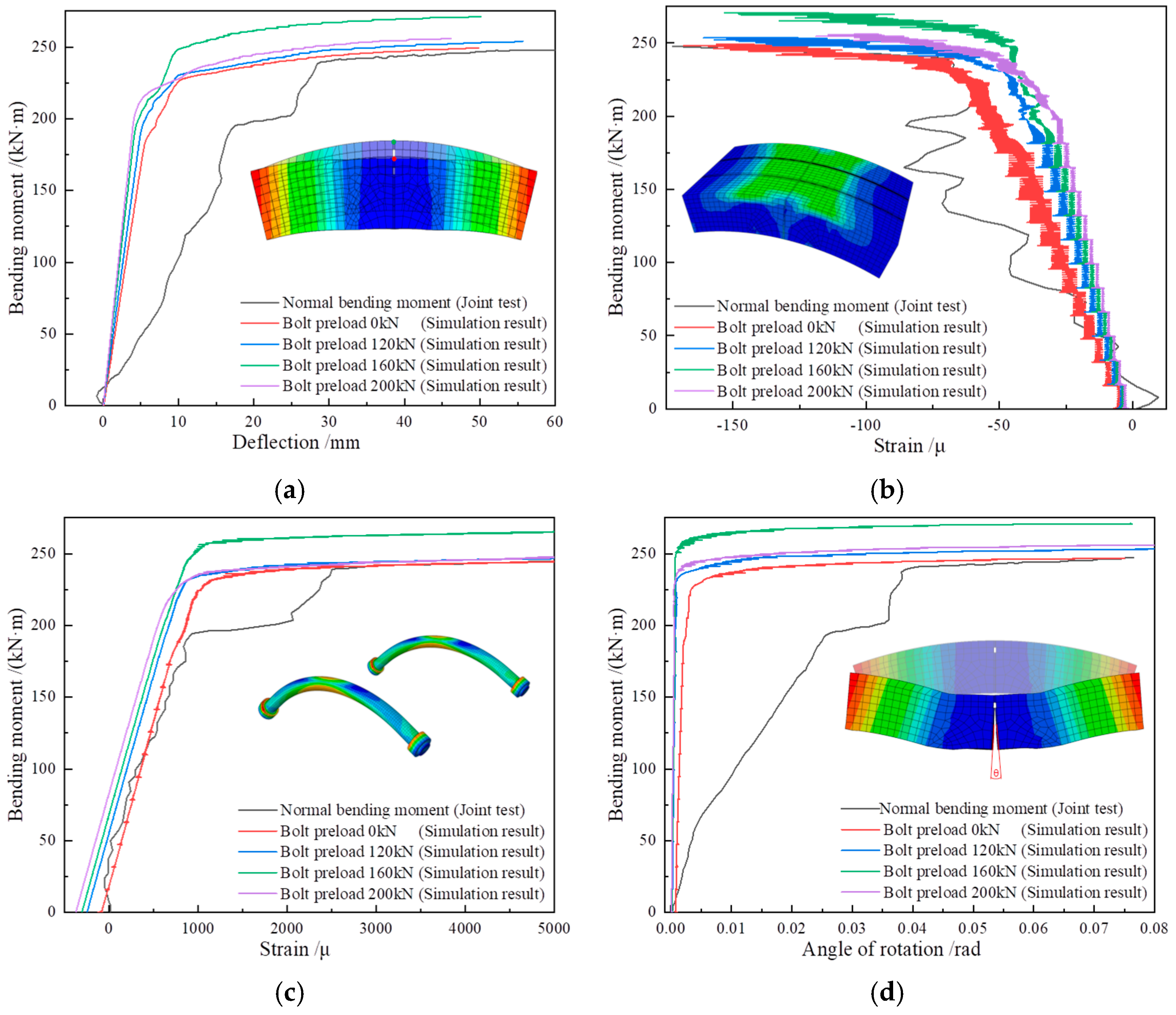



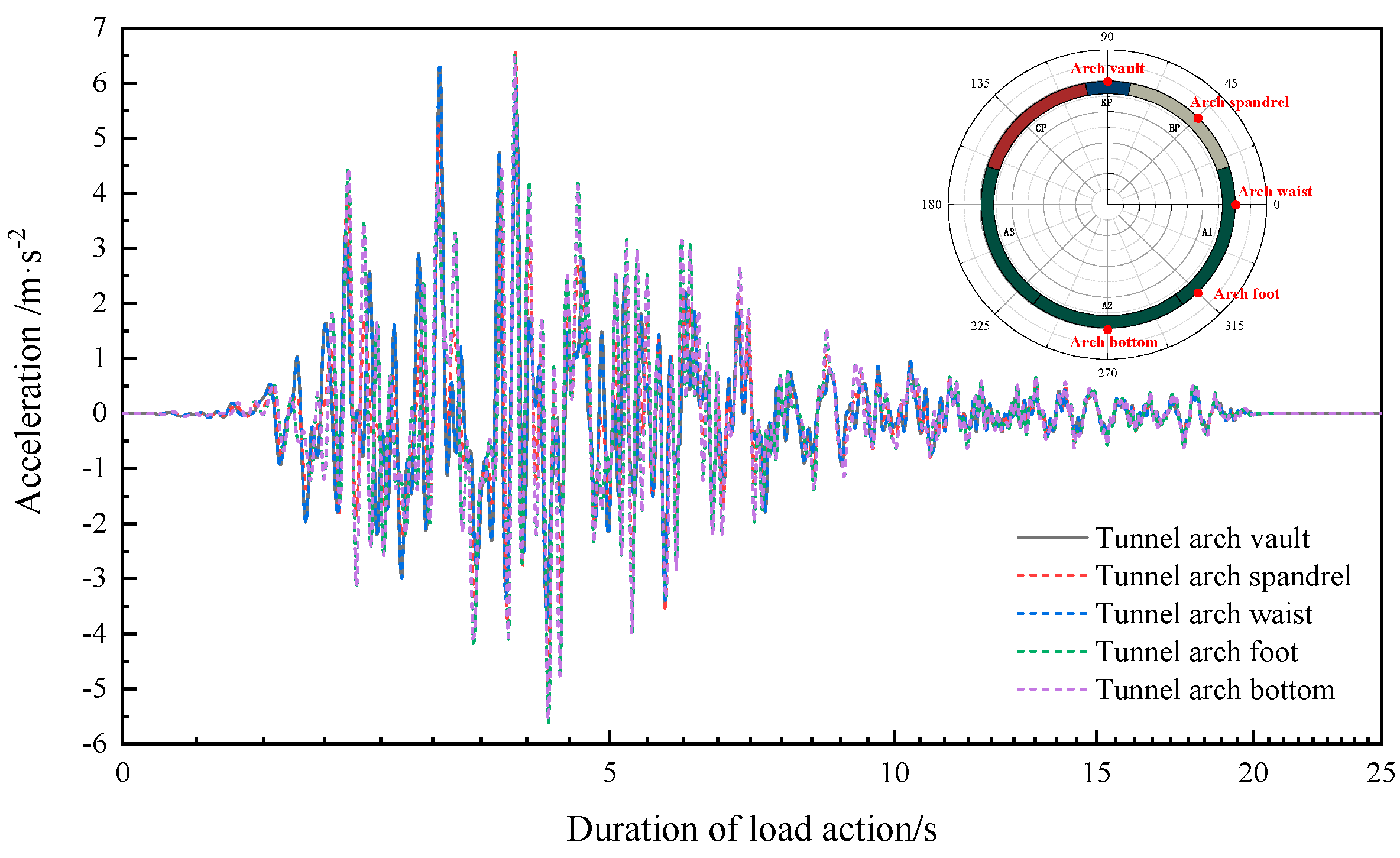
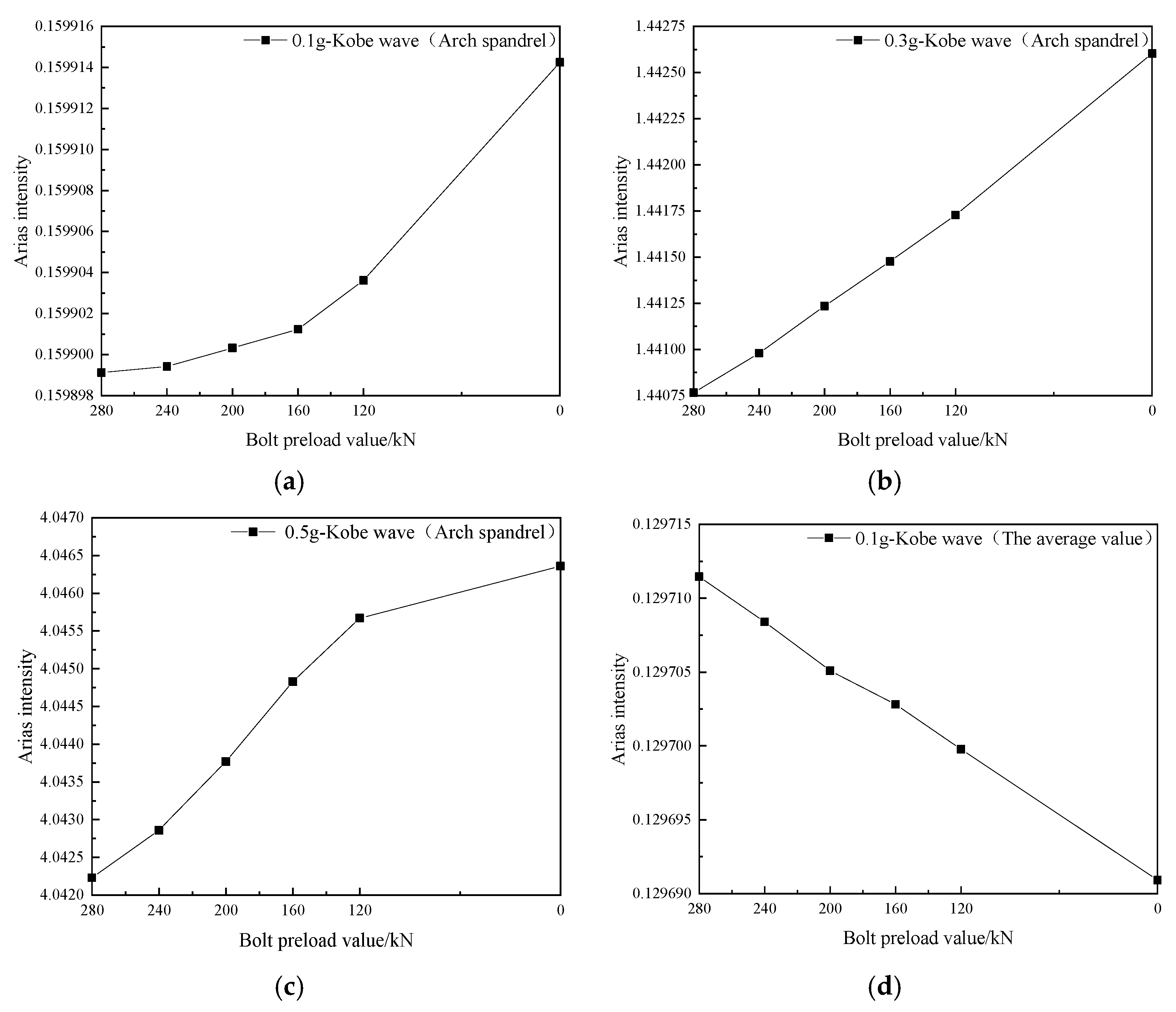


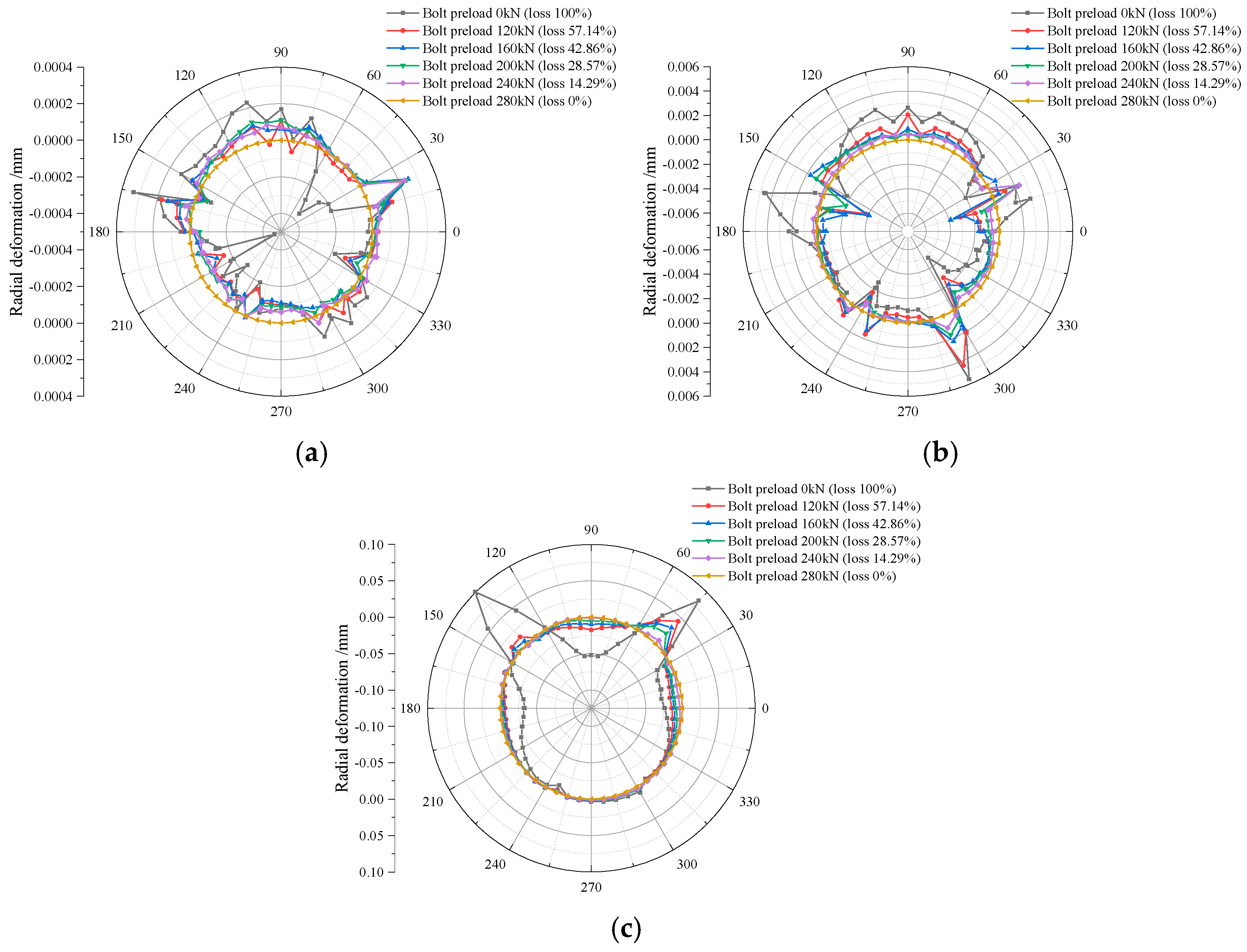
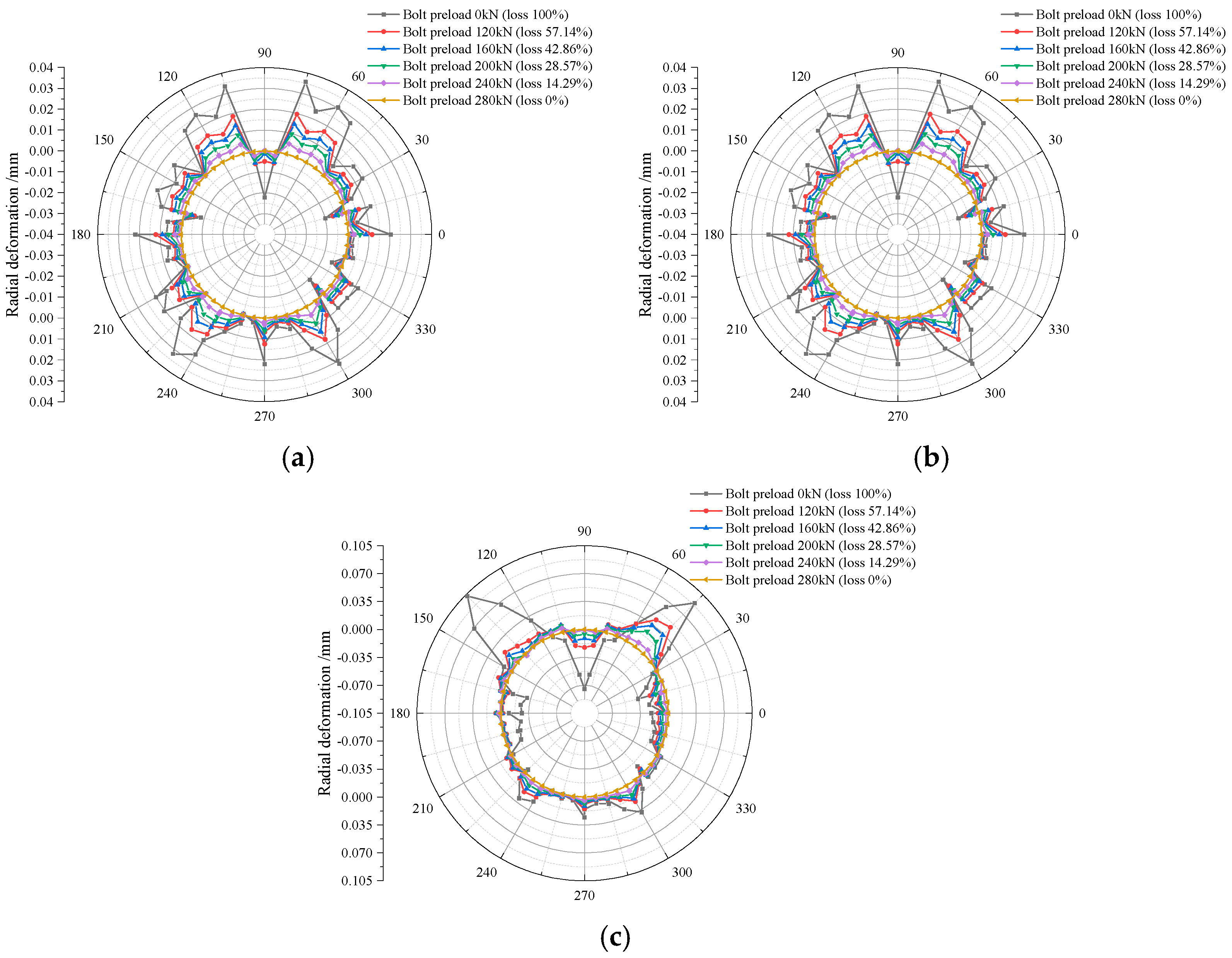

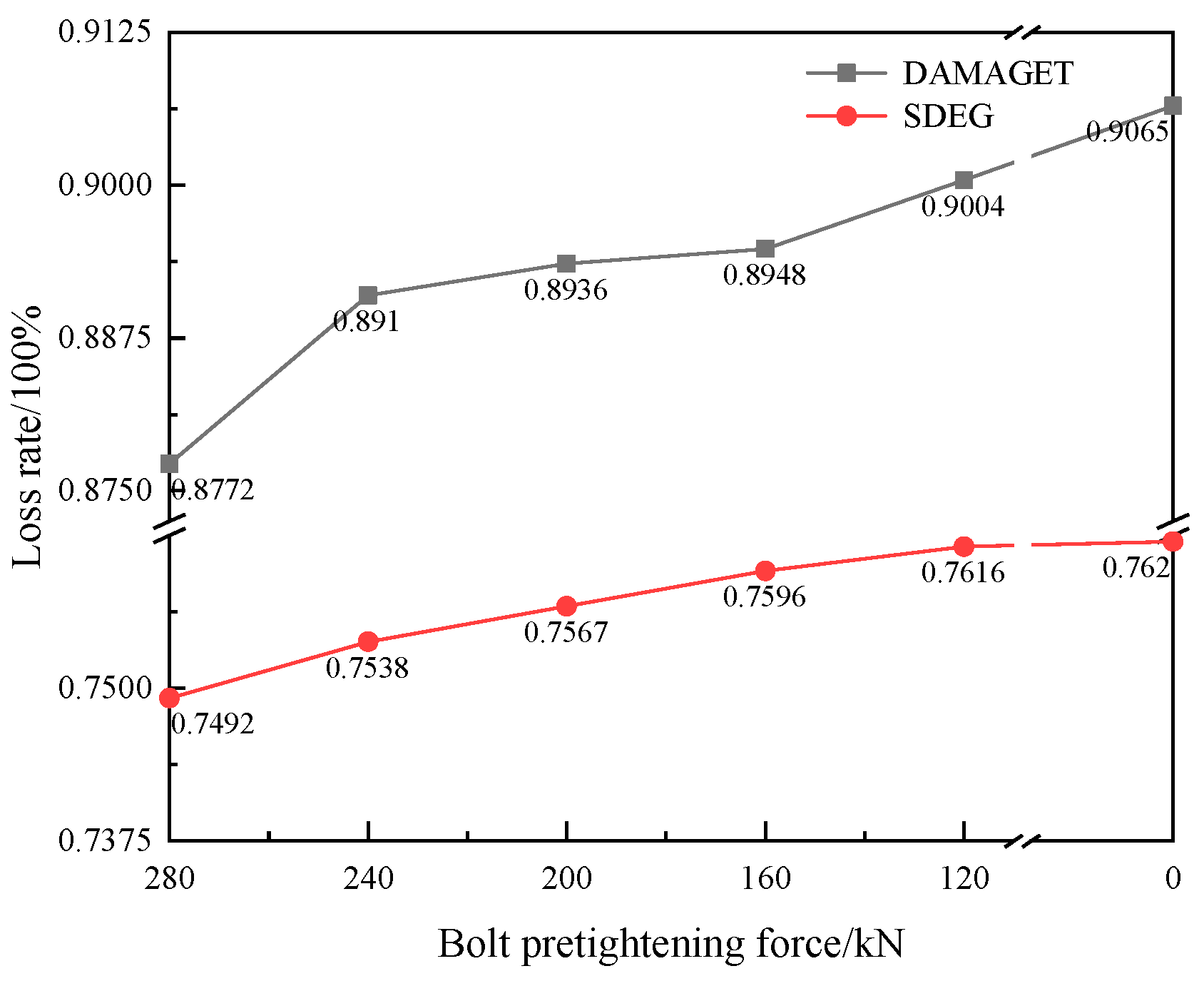
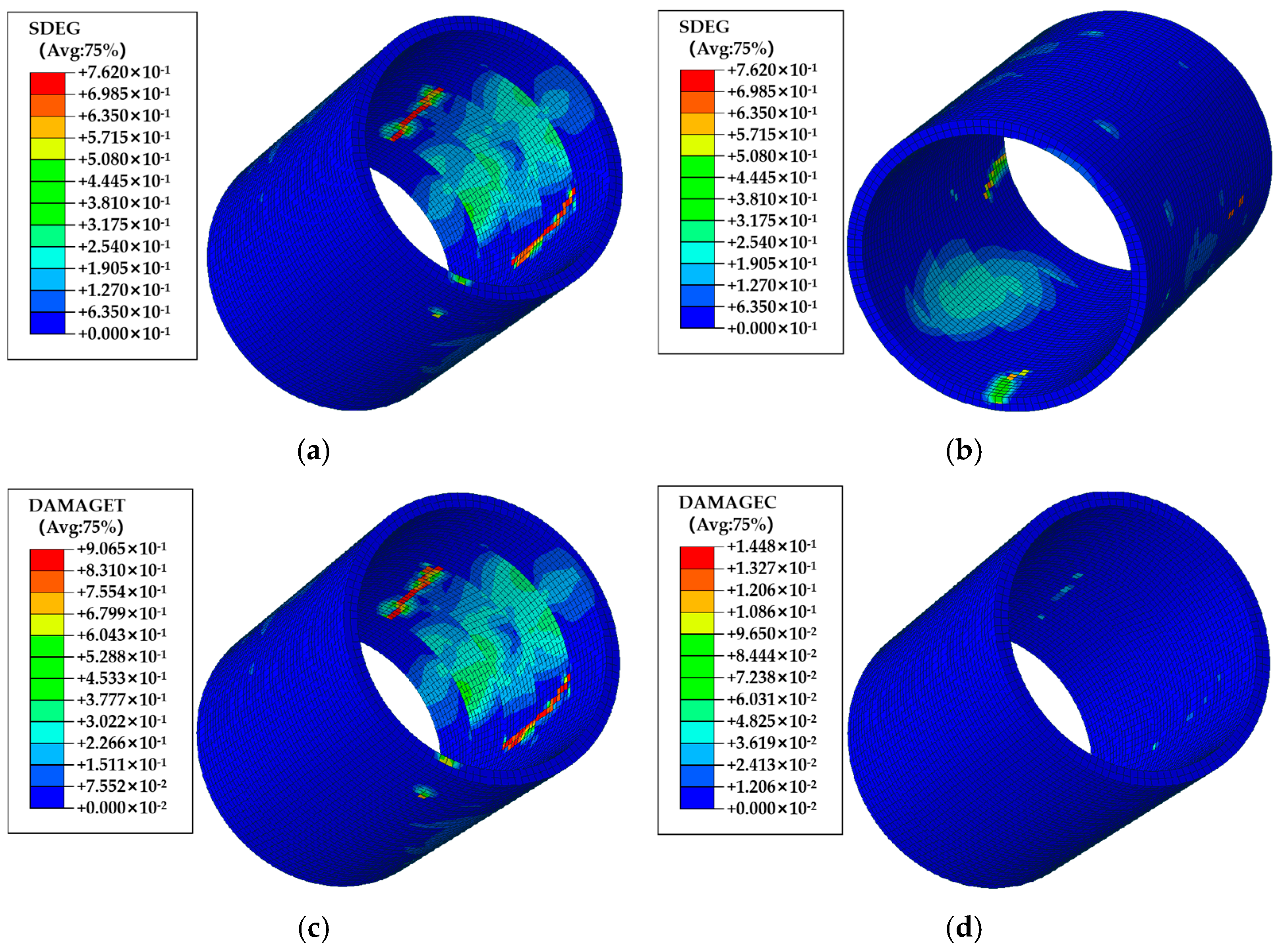

| Uniaxial Compression | |||||
|---|---|---|---|---|---|
| Stress (MPa) | Inelastic Strain | Damage Factor | Stress (MPa) | Cracking Strain | Damage Factor |
| 26.892 | 0 | 0 | 3.423939 | 0 | 0 |
| 38.455 | 6.6 | 0.208666 | 3.257697 | 0.3 | 0.125466 |
| 34.997 | 10.9 | 0.309287 | 2.701560 | 1.1 | 0.349736 |
| 28.692 | 16.2 | 0.420016 | 2.169453 | 1.8 | 0.495345 |
| 23.006 | 21.2 | 0.513588 | 1.561394 | 3.2 | 0.650423 |
| 18.640 | 25.8 | 0.586791 | 1.045034 | 5.8 | 0.778459 |
| 15.401 | 30.2 | 0.643377 | 0.675897 | 10.7 | 0.867185 |
| 12.985 | 34.3 | 0.687565 | 0.430703 | 20.5 | 0.922839 |
| 9.725 | 42.0 | 0.751014 | 0.272294 | 40.0 | 0.955944 |
| 6.315 | 56.6 | 0.824267 | 0.171334 | 78.7 | 0.975075 |
| 3.624 | 84.5 | 0.890016 | 0.107651 | 156.0 | 0.985949 |
| 1.784 | 148.0 | 0.941518 | 0.067876 | 308.0 | 0.992065 |
| 0.032288 | 953.0 | 0.996891 | |||
| Material | Young’s Modulus (MPa) | Poisson’s Ratio | Mass Density | Damping Ratio |
|---|---|---|---|---|
| Silty clay | 126 | 0.35 | 1.85 | 0.09 |
| Concrete | 34,500 | 0.20 | 2.42 | 0.02 |
| Bolt | 210,000 | 0.3 | 7.85 | 0.05 |
| Preload (kN) | Preload Loss Rate (%) | Temperatures (°C) | Carrying Capacity Redundancy (kN) |
|---|---|---|---|
| 280 | 0 | −150.86 | 172.39 |
| 240 | 14.29 | −129.31 | 212.39 |
| 200 | 28.57 | −107.76 | 252.39 |
| 160 | 42.86 | −86.21 | 292.39 |
| 120 | 57.14 | −64.66 | 332.39 |
| 0 | 100 | 0 | 372.39 |
Disclaimer/Publisher’s Note: The statements, opinions and data contained in all publications are solely those of the individual author(s) and contributor(s) and not of MDPI and/or the editor(s). MDPI and/or the editor(s) disclaim responsibility for any injury to people or property resulting from any ideas, methods, instructions or products referred to in the content. |
© 2023 by the authors. Licensee MDPI, Basel, Switzerland. This article is an open access article distributed under the terms and conditions of the Creative Commons Attribution (CC BY) license (https://creativecommons.org/licenses/by/4.0/).
Share and Cite
Cui, H.; Tao, R.; Shen, J.; Wu, X.; Bao, X.; Liu, Z.; Chen, X. Study on the Seismic Response of Shield Tunnel Structures with the Preload Loss of Bolts. Appl. Sci. 2023, 13, 12889. https://doi.org/10.3390/app132312889
Cui H, Tao R, Shen J, Wu X, Bao X, Liu Z, Chen X. Study on the Seismic Response of Shield Tunnel Structures with the Preload Loss of Bolts. Applied Sciences. 2023; 13(23):12889. https://doi.org/10.3390/app132312889
Chicago/Turabian StyleCui, Hongzhi, Ran Tao, Jun Shen, Xianlong Wu, Xiaohua Bao, Ziming Liu, and Xiangsheng Chen. 2023. "Study on the Seismic Response of Shield Tunnel Structures with the Preload Loss of Bolts" Applied Sciences 13, no. 23: 12889. https://doi.org/10.3390/app132312889





